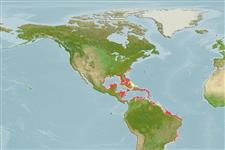>
Blenniiformes (Blennies) >
Labrisomidae (Labrisomids)
Etymology: Malacoctenus: Greek, malakos = soft + Greek, kteis, ktenos = comb (Ref. 45335).
Eponymy: Pierre Antoine Delalande (1787–1823) was a French naturalist and explorer who worked for Muséum National d’Histoire Naturelle, Paris. [...] (Ref. 128868), visit book page.
More on author: Valenciennes.
Environment: milieu / climate zone / profondeur / distribution range
Écologie
marin récifal. Tropical
Southwestern Atlantic: Belize, Central America, and Puerto Rico; Caribbean, to
Santa Catarina State, southern Brazil.
Taille / Poids / Âge
Maturité: Lm ? range ? - ? cm
Max length : 8.2 cm TL mâle / non sexé; (Ref. 13628)
Épines dorsales (Total) : 20; Rayons mous dorsaux (Total) : 9 - 11; Épines anales: 2; Rayons mous anaux: 7 - 21. This species is distinguished from its southwestern Atlantic congeners by the following set of characters: D XX,9-11 (rarely XIX or XXI); A II,17-21; pectoral-fin rays14-15 (rarely 13); length of third pelvic-fin ray contained 2.5 to 3.0 times in second pelvic-fin ray; lateral-line scales 48-56; total nuchal cirri 24-36; pectoral-fin base and midline before dorsal-fin no scales; breast usually fully scaled in males, often naked in females; pores 2-3 from preopercular canal onto opercle. Colouration: pattern dominated by 5-6 (rarely 7), saddle-like bars on body, extending to spiny dorsal fin (Ref. 123106).
Cross section: oval.
Occurs in shallo reefs (Ref. 123106), on sandy bottoms and Thalassia testudinum beds (Ref. 13628). Feeds mainly on crustaceans but also on gastropods and worms (Ref. 13628).
Life cycle and mating behavior
Maturité | Reproduction | Frai | Œufs | Fécondité | Larves
Carvalho-Filho, A., I. Sazima, S.M.Q. Lima, D. Almeida, L. Mendes, R.M. Dias, M.R. Britto and J.L. Gasparini, 2020. Review of the genus Malacoctenus (Actinopterygii: Labrisomidae) from the Southwestern Atlantic, with description of two new species. Zootaxa 4819(3):499-520. (Ref. 123106)
Statut dans la liste rouge de l'IUCN (Ref. 130435: Version 2025-1)
Menace pour l'homme
Harmless
Utilisations par l'homme
Outils
Articles particuliers
Télécharger en XML
Sources Internet
Estimates based on models
Preferred temperature (Réf.
123201): 24.1 - 28.1, mean 27.3 °C (based on 722 cells).
Phylogenetic diversity index (Réf.
82804): PD
50 = 0.5000 [Uniqueness, from 0.5 = low to 2.0 = high].
Bayesian length-weight: a=0.00646 (0.00319 - 0.01305), b=3.07 (2.88 - 3.26), in cm total length, based on LWR estimates for this species & (Sub)family-body (Ref.
93245).
Niveau trophique (Réf.
69278): 3.4 ±0.49 se; based on food items.
Résilience (Réf.
120179): Milieu, temps minimum de doublement de population : 1,4 à 4,4 années (Fec = 4,000).
Fishing Vulnerability (Ref.
59153): Low vulnerability (10 of 100).
🛈
Nutrients (Ref.
124155): Calcium = 146 [72, 238] mg/100g; Iron = 0.757 [0.435, 1.292] mg/100g; Protein = 18.2 [17.1, 19.3] %; Omega3 = 0.0978 [, ] g/100g; Selenium = 22.2 [9.4, 48.7] μg/100g; VitaminA = 181 [57, 582] μg/100g; Zinc = 2.25 [1.47, 3.24] mg/100g (wet weight);
